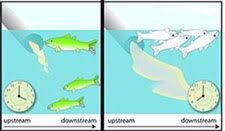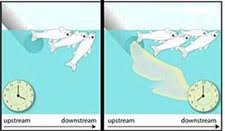Temporal Sequence
Concept
Temporal Sequence: The cause must precede the biological effect.

Click for more information

Click for more information
Examples
Consider reduced water flow as a candidate cause of low benthic macroinvertebrate species richness. What findings support or weaken the case for reduced water flow as the cause, based on temporal sequence?
- Supporting evidence - Monitoring data show a diverse macroinvertebrate community, but after water is diverted for irrigation species richness of the community declines. This sequence of events supports the case for reduced water flow as a cause, since the biological effect occurred only after water flow was diminished.
- Weakening evidence - Monitoring data show a depauperate macroinvertebrate community, and after water is diverted for irrigation the community is unchanged. This lack of a cause-effect temporal sequence weakens the case for reduced water flow as a cause, and suggests that the biological community was impaired by some factor other than reduced water flow.
How Do I Analyze the Data?
Temporal sequence evidence is uncommon, because it usually depends upon data collected over relatively long time scales, often before an observed impairment suggests when and where data should be collected. Only measurements of the candidate causal agent (i.e., the proximate stressor) should be used to evaluate temporal sequence: surrogates or measurements of other steps in the causal pathway are considered under other types of evidence. Statistical tests should be interpreted with caution.
Evidence of temporal sequence should be evaluated cautiously if multiple sufficient causes may be present, as well as when the objective of the analysis is to identify all contributing causes rather than the most likely cause first. Under these circumstances, candidate causes occurring early in the time sequence may mask the effects of candidate causes occurring later, even though those candidates may contribute to the observed effects.
What Evidence Would Support or Weaken the Case for a Candidate Cause?
- Data showing that the candidate cause preceded the effect
- Data showing that the effect preceded the candidate cause
- Data showing, with certainty, that the effect preceded the candidate cause
How Do I Score the Evidence?
| Finding | Interpretation | Score |
|---|---|---|
| The candidate cause occurred prior to the effect. | This finding somewhat supports the case for the candidate cause, but is not strongly supportive because the association could be coincidental. | + |
| The temporal relationship between the candidate cause and the effect is uncertain. | This finding neither supports nor weakens the case for the candidate cause, because the evidence is ambiguous. | 0 |
| The candidate cause occurs after the effect. | This finding convincingly weakens the case for the candidate cause, because causes cannot precede effects (note that this should be evaluated with caution when multiple sufficient causes are present). | --- |
| The candidate cause occurs after the effect, and the evidence is indisputable. | This finding refutes the case for the candidate cause, because effects cannot precede causes. | R |
Helpful Tips
- Only the time order of the candidate cause and the observed effect is evaluated under temporal sequence - whether the magnitude of change in the stressor is sufficient to have caused the effect is evaluated later.
- Occurrence of the candidate cause and the effect at the same time, without evidence of which began first, is evidence of temporal co-occurrence, not temporal sequence.
